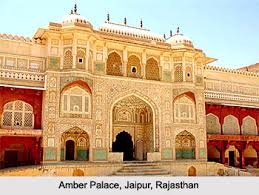RAJPUTANA ART
 |
| Rajputana Art |
Rajput is the art of 17 th to 19 th century India and it is an extension of the independent Rajput principalities in the Rajasthan region and the Punjab mountain area in Northwest India . It was the Rajputs who kept Hindi culture and art alive throughout the long Muhammadan rule. The Rajputs were the dominant peoples of Rajputana, historically a part of Rajasthan in northwest India . They were called 'rajput', meaning 'son of king' to denote their traditional warrior caste and they were great in power during the 7 th century onwards. However, they suffered a decline of power and by 1616 all the major clans of the Rajput peoples had been conquered by the Mughals and their culture partially assimilated. Despite even this travesty Rajput culture refused to be obliterated and the respites from war commonly dedicated to poetry, art and the other refinements of culture. With the decline of Mughal power in the 18 th century, the Rajputs sensed an opportunity ion the offing and began expanding their territories into the central plains of India, though they met constant resistance all the way there. By the early 19 th century they were again driven back to their established lands in the north-west.
The decline of Rajput art in the 17 th century
Rajput art is a blend that came about from circumstance. With the accession of the Mughal Emperor Aurangzeb in the mid 17 th century came the decline of Mughal art. Aurangzeb was the first Mughal leader to withdraw all funding for the arts, and even from the writing of history books, which had been a necessary price for all the foreign leaders attempting to rewrite history in their favor. By 1670 there were no more artists in the Emperial court, and most had fled north to be patronized by the great Maharajas of Rajasthan or to the poorer, more obscure Rajas in the Punjab hills. There they blended Moghul art with Rajput style, creating an old technique of new symbolism and rhythm.
The characteristics of Rajput art:
Rajputian painting is mainly diverse depictions of the god Krishna in his various stages of life. Having already stated the pride of heritage in their warrior caste, many painting were also made to reflect the chivalric class and the etiquette associated with such lofty station. This was a fundamentally Hindi style of art that went against the prevalent style of the ruling Mogul princes and their courts. Far simpler in composition, with bright and vivid clashes of color, the Rajput work is also far more subtle and sophisticated. It has its artistic foundations in the art of Western India in the mid 15 th century and this influence made its way north and east. There are also some Persian elements of color patterning. The technique used to accomplish this was first to trace the contours of the image with red paint or dye, allowing time for corrections, and only then painting the hemp or paper. Lastly they would seal the paint to the wall or fabric with a thin application of glue that they made from the gum of certain plants. At first the images depicted were mainly reserved for the illustration of books, but as the centuries progressed, many portraits and wall murals of everyday life scenes have been found. The genius of the Rajputans is not only in the great gift of painting that many works exhibit, but the obvious and secret skill with which they made their vivid dyes, still bright till this day. Recipies for color-concoctions were handed down with fanatical secrecy from one generation to the next; among them the famous Rajput blue and the deeply dark blood red. Great emphasis was put on capturing the right posture of the figure, down to each last fingertip, portraying true emotion and atmosphere through compositions and coloring.


0 Comments:
It is our hope that by providing a stage for cultural, social, and professional interaction, we will help bridge a perceived gap between our native land and our new homelands. We also hope that this interaction within the community will allow us to come together as a group, and subsequently, contribute positively to the world around us.